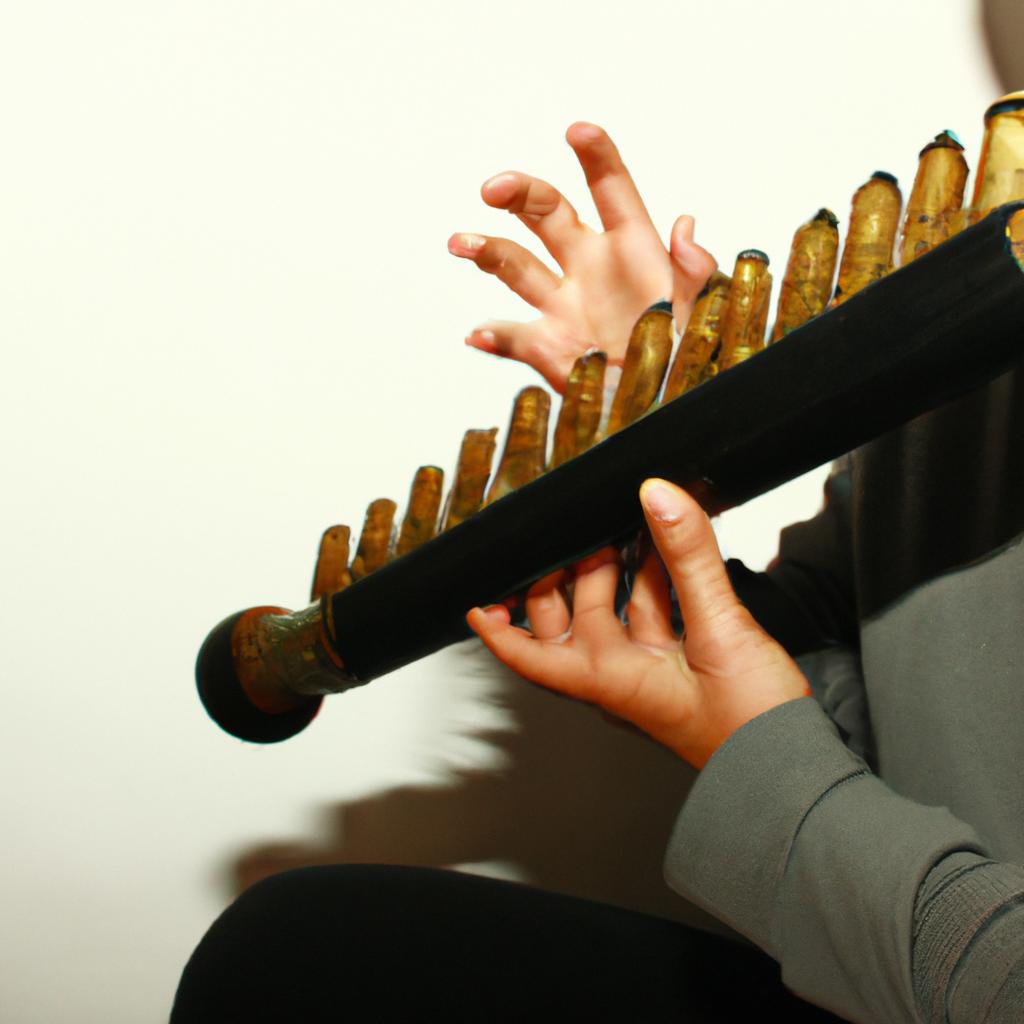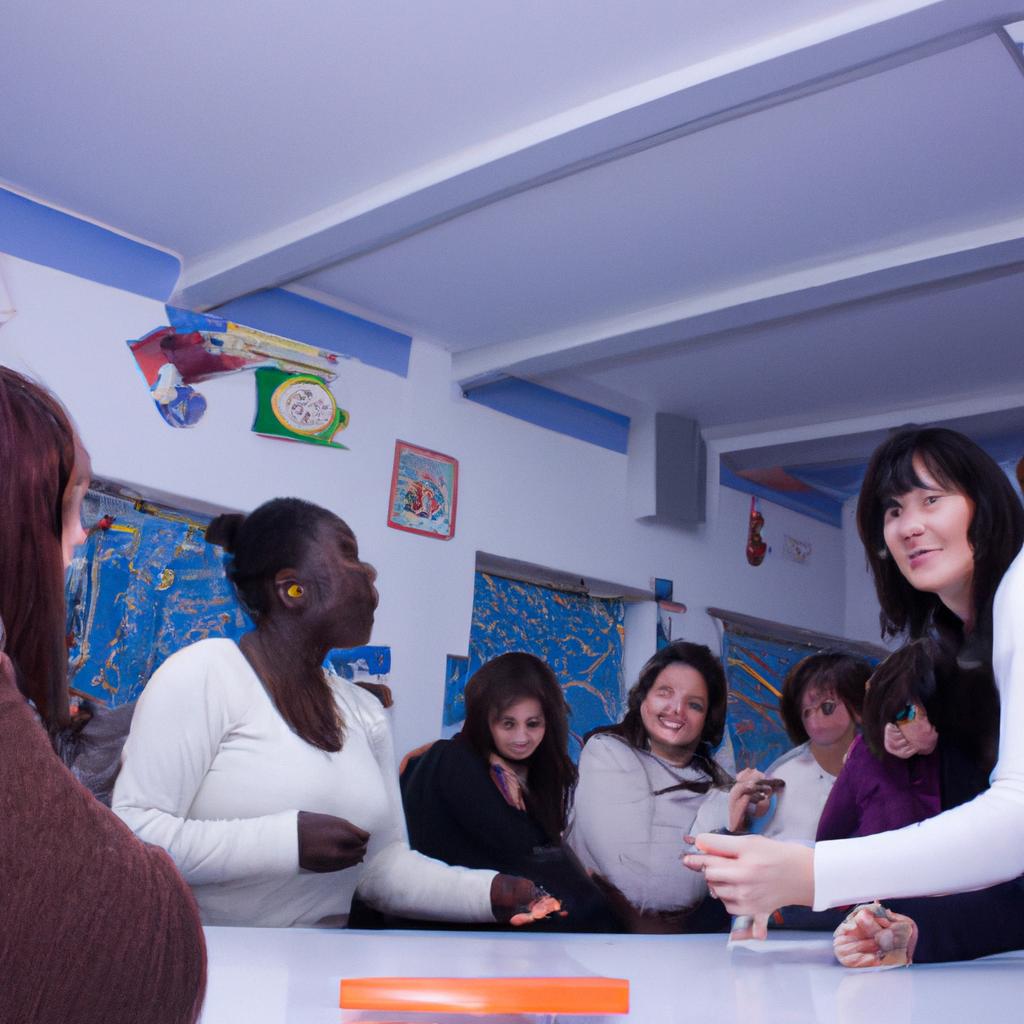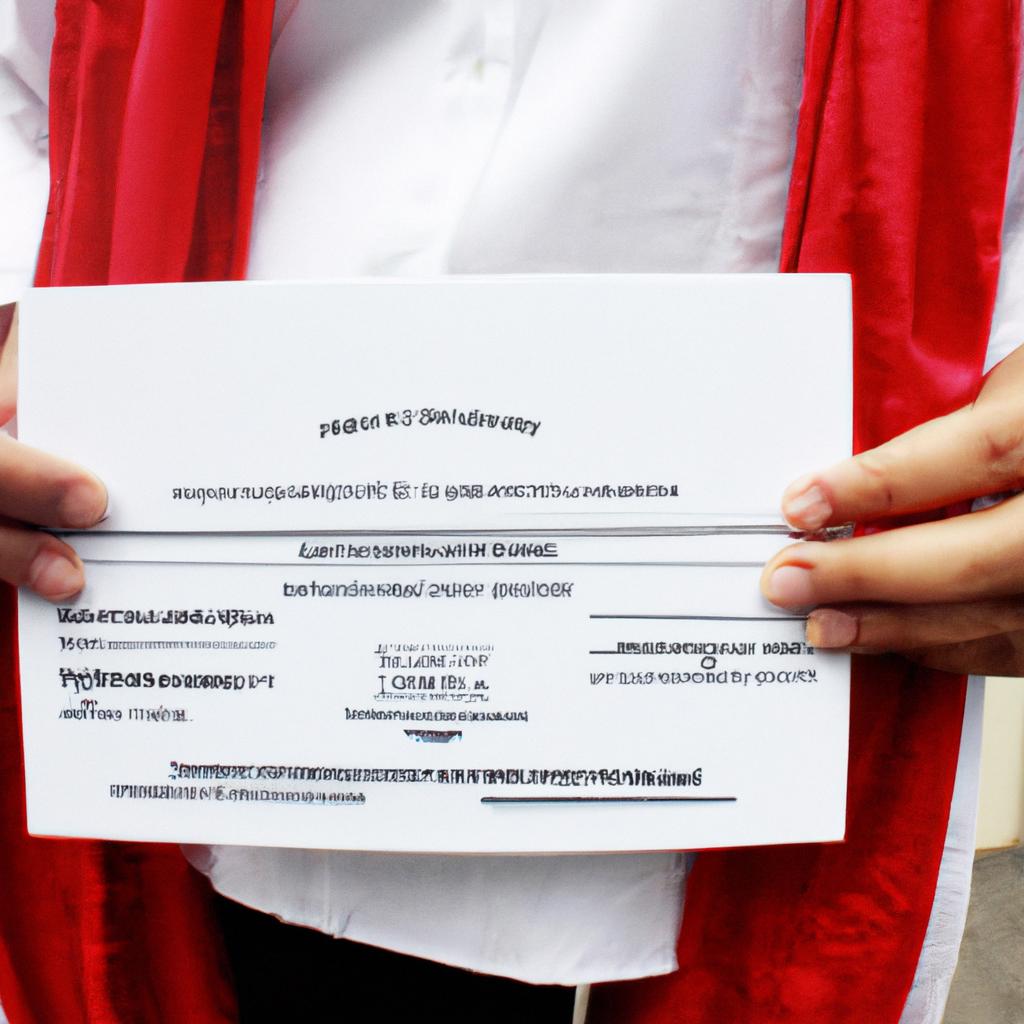Musical mastery is an alluring pursuit that requires dedication, skill, and a well-structured educational pathway. Consider the case of Jane, a talented young violinist with dreams of becoming a professional musician. Despite her natural talent and passion for music, she quickly realized that simply possessing raw musical ability was not enough to reach her goals. To truly master her craft and navigate the complex world of music, Jane needed to embark on a carefully curated educational journey.
The path towards mastering music encompasses various educational pathways that provide aspiring musicians with the necessary tools and knowledge to excel in their chosen field. This article explores these pathways in depth, shedding light on the different aspects of musical education and how they contribute to the development of skilled musicians. By delving into the diverse options available, such as conservatories, universities, private lessons, and specialized programs, this article aims to guide individuals like Jane towards making informed decisions about their own musical education.
In order to understand the significance of educational pathways for musicians, it is essential to recognize the multifaceted nature of musical mastery itself. Mastery goes beyond mere technical proficiency; it involves a deep understanding and interpretation of musical concepts combined with artistic expression. Achieving such mastery necessitates comprehensive training under expert guidance along with ample opportunities to refine and showcase one’s skills.
Conservatories are renowned institutions that offer intensive training programs specifically designed to cultivate musical talent. These institutions focus on providing a rigorous curriculum that covers a wide range of musical disciplines, including theory, composition, history, and performance. Students at conservatories often have the opportunity to learn from distinguished faculty members who are accomplished musicians themselves. This immersive environment allows aspiring musicians like Jane to immerse themselves in music and receive specialized training that prepares them for professional careers.
Universities also play a significant role in shaping the education of musicians. Many universities offer undergraduate and graduate degree programs in music, allowing students to explore various aspects of music while also gaining a well-rounded education. University programs often include courses in music theory, history, pedagogy, and performance techniques. Additionally, universities provide opportunities for students to collaborate with other musicians through ensembles, orchestras, or choirs.
Private lessons are another vital component of a musician’s educational journey. Working closely with a private instructor allows individuals like Jane to receive personalized attention and guidance tailored to their specific needs and goals. Private lessons can help develop technical skills, refine musical interpretation, and provide valuable feedback on performance abilities. Many successful musicians credit their private instructors for playing an instrumental role in their development as artists.
Specialized programs and workshops offer additional avenues for honing one’s craft. These programs can focus on specific genres or styles of music or cater to particular instruments or techniques. Participating in these programs provides aspiring musicians with unique learning experiences and opportunities to connect with industry professionals and fellow musicians.
In addition to formal education pathways, there are numerous resources available online that can supplement an individual’s musical education journey. Online platforms offer instructional videos, sheet music libraries, practice tools, and forums where aspiring musicians can connect with peers from around the world.
Ultimately, mastering music requires not only choosing the right educational pathway but also maintaining dedication, discipline, and a genuine passion for the art form. By carefully considering the various educational pathways available and taking advantage of the resources and opportunities provided, individuals like Jane can embark on a fulfilling and successful journey towards musical mastery.
Exploring Different Musical Genres
Exploring Different Musical Genres
When it comes to mastering music, aspiring musicians often find themselves navigating through a diverse landscape of musical genres. To illustrate this point, let’s consider the case of Sarah, a talented pianist who wishes to explore different musical styles in her journey as a musician.
Sarah’s passion for classical piano has been undeniable since she began playing at the age of eight. However, she recently developed an interest in jazz and electronic music after attending a concert where these genres were creatively fused together. This newfound curiosity led her on a path of exploration into various musical genres, each offering unique elements that captivate both performers and audiences alike.
- Emotional Connection: One significant aspect of exploring different musical genres is the ability to evoke distinct emotions within listeners. For instance, while classical compositions may elicit feelings of elegance and nostalgia, jazz can create an atmosphere of improvisation and spontaneity. Electronic music, on the other hand, has the power to transport individuals into futuristic soundscapes filled with energy and excitement.
| Classical | Jazz | Electronic |
|---|---|---|
| Elegance | Improvisation | Energy |
| Nostalgia | Spontaneity | Excitement |
-
Cultural Diversity: Engaging with multiple musical genres allows musicians like Sarah to embrace cultural diversity by immersing themselves in different traditions and practices associated with each genre. By delving into new styles such as flamenco or reggae, artists gain insight into the historical contexts from which these genres emerged. This exposure broadens their understanding of music as a universal language capable of transcending borders.
-
Expanded Skill Set: Exploring diverse musical genres helps musicians develop versatility in their skills. In addition to technical proficiency required for classical repertoire interpretation, they learn improvisational techniques crucial in jazz performance or production skills necessary for creating electronic compositions. These additional skills not only enhance their musicianship but also provide them with a competitive edge in the ever-evolving music industry.
As Sarah delves deeper into her exploration of different musical genres, she discovers that this journey is not just about expanding her repertoire. It is an opportunity to grow as a musician and develop a unique artistic voice that transcends boundaries. In the subsequent section on “Developing Technical Skills,” we will explore how mastering technical aspects further complements this artistic development, allowing musicians like Sarah to fully express themselves through various musical styles.
Developing Technical Skills
Transitioning from the previous section, where we discussed how musicians can broaden their horizons by exploring different musical genres, it is important to now delve into the significance of developing technical skills. To illustrate this point, let us consider a hypothetical scenario involving a musician named Alex.
Alex, an aspiring guitarist, primarily focuses on playing rock music. However, they decide to explore jazz as well in order to expand their versatility as a musician. By delving into jazz guitar techniques and immersing themselves in the intricacies of improvisation and chord progressions unique to this genre, Alex gains new insights that enhance their overall musicianship. This example highlights the transformative power of venturing beyond one’s comfort zone and embracing diverse musical styles.
Developing technical skills plays a crucial role in a musician’s journey towards mastery. Here are some key reasons why honing these skills should be prioritized:
- Enhanced Expressiveness: Technical proficiency enables musicians to fully express themselves through their chosen instrument or voice.
- Expanded Artistic Vocabulary: Mastering various techniques allows musicians to communicate effectively within different musical idioms.
- Increased Adaptability: Developing technical skills equips musicians with the ability to adapt and perform across multiple genres and settings.
- Heightened Creativity: Proficiency in technique opens up new avenues for creative expression, enabling musicians to push boundaries and innovate.
To emphasize further the importance of technical skill development, consider the following table showcasing notable artists who have successfully ventured outside their primary genre:
| Artist | Primary Genre | Exploration(s) |
|---|---|---|
| Paul McCartney | Rock | Classical |
| Esperanza Spalding | Jazz | Soul/R&B |
| Yo-Yo Ma | Classical | World Music |
| Herbie Hancock | Jazz | Electronic/Dance |
As we can see, these renowned musicians have diversified their musical repertoire by venturing into different genres. Their willingness to develop technical skills beyond their comfort zones has not only expanded their artistic horizons but also influenced the evolution of their primary genre.
Transitioning seamlessly from exploring various musical genres and developing technical skills, an essential aspect of a musician’s educational pathway is gaining a solid foundation in music theory. By comprehending the underlying principles that govern melody, harmony, rhythm, and structure, musicians acquire a comprehensive toolkit for composition, improvisation, and analysis.
Understanding Music Theory
Having established a solid foundation in developing technical skills, musicians must now embark on the journey of understanding music theory. This crucial aspect of musical education allows them to unlock the inner workings of compositions and deepen their overall understanding of music. By delving into concepts such as harmony, melody, rhythm, and form, musicians can elevate their performances to new heights.
To illustrate the importance of music theory, let us consider an example involving a young pianist named Emily. Despite possessing exceptional technical prowess, she found herself struggling when it came to interpreting complex pieces with nuanced expression. Recognizing this limitation, Emily decided to devote time to studying music theory alongside her technical practice.
Music theory encompasses various key elements that shape how composers structure their works. A comprehensive understanding of these elements enables musicians like Emily to make informed interpretive choices while performing. Some fundamental aspects covered in music theory include:
- Harmony: The study of chords and chord progressions that underpin a composition.
- Melody: Focusing on the individual lines or themes within a piece.
- Rhythm: Examining patterns of duration and timing.
- Form: Analyzing the overarching structure and organization of a work.
By grasping these core concepts through dedicated study, musicians gain insight into the intentions behind each note on the page. With this knowledge at their disposal, they can infuse their performances with emotion and convey the composer’s intended message effectively.
Embracing music theory also involves practical application through exercises such as analyzing scores and composing original pieces. These activities allow aspiring musicians like Emily to internalize theoretical principles and apply them creatively. Here is an example table demonstrating some possible areas where musicians can utilize their newfound knowledge:
| Application | Description |
|---|---|
| Score Analysis | Examining the structure, harmonic progression, and thematic development of a composition. |
| Composition | Creating original works while utilizing theoretical principles to guide artistic decisions. |
| Improvisation | Applying theoretical knowledge spontaneously in real-time musical situations. |
| Collaborative Projects | Working with other musicians to explore various genres and styles through collective creativity. |
By engaging in these practical endeavors, musicians not only deepen their understanding but also foster their own unique musical voice.
Having established a solid foundation in technical skills and delved into music theory, aspiring musicians can then turn their attention towards studying notation and sight-reading. This vital step allows them to effectively interpret written scores and bring compositions to life on their instruments or through vocal performance.
Studying Notation and Sight-Reading
Building upon the foundation of understanding music theory, musicians can further enhance their skills by studying notation and sight-reading. This section explores the importance of these disciplines in mastering music and offers practical insights into how musicians can improve their abilities.
Section – Studying Notation and Sight-Reading:
To illustrate the significance of studying notation and sight-reading, let’s consider a hypothetical scenario involving a pianist named Sarah. Sarah is an accomplished musician who has been playing the piano for several years. However, she struggles with reading sheet music fluently and performing pieces on sight without prior practice. By focusing on notation and sight-reading, Sarah can overcome these challenges and elevate her musical proficiency to new heights.
Notation:
- Notation serves as a universal language that allows musicians to communicate ideas effectively.
- Learning different notational systems enables musicians to read and interpret various types of written music accurately.
- Mastering notation empowers musicians to better understand the composer’s intentions, enhancing their ability to express emotions through their performances.
- Through diligent study and practice of notation, musicians develop a keen eye for detail, enabling them to identify complex rhythms, articulations, dynamics, and other nuances within a musical score.
Sight-Reading:
- Sight-reading refers to the skill of being able to play or sing a piece of music at first glance.
- It requires quick thinking, coordination between eyes and hands (or voice), and familiarity with common patterns in music.
- Developing strong sight-reading skills enables musicians to learn new repertoire efficiently, making them more versatile performers.
- Regular exercises focused on sight-reading help build confidence when encountering unfamiliar musical passages during live performances or auditions.
Concluding paragraph:
By dedicating time and effort towards studying notation and improving sight-reading abilities, musicians like Sarah can unlock new possibilities in their musical journey. These foundational skills provide invaluable tools for understanding and performing music with precision and artistry. In the subsequent section on “Improving Performance Techniques,” we will explore further avenues that musicians can pursue to refine their musicality and enhance their overall performance skills.
With a solid grasp of notation and sight-reading, musicians can now focus on improving their performance techniques.
Improving Performance Techniques
Transitioning smoothly from the previous section that explored the importance of studying notation and sight-reading, we now delve into another crucial aspect of musical education: improving performance techniques. To illustrate this, let’s consider the hypothetical case of a young pianist named Emily.
Emily has been honing her skills in reading sheet music and playing the piano with proficiency. However, she realizes that there is more to delivering an exceptional performance than simply hitting the right notes. She understands that refining her technique will not only enhance her musicianship but also captivate audiences with her expressive interpretation.
To achieve mastery in performance techniques, aspiring musicians like Emily can follow these key steps:
- Body Awareness: Developing a heightened sense of body awareness allows musicians to harness their physicality effectively while performing. This entails understanding proper posture, hand positioning, and breathing techniques tailored to their specific instrument or voice type.
- Articulation and Dynamics: The way notes are played contributes significantly to the overall impact of a piece. Mastering articulation techniques such as legato (smoothly connected), staccato (short and detached), or accents brings depth and nuance to performances. Additionally, incorporating dynamics – variations in volume ranging from soft (piano) to loud (forte) – adds emotional intensity.
- Interpretation and Expression: Beyond technical precision lies the artistry of interpretation and expression. Musicians must dig deeper into the meaning behind compositions, understanding historical context or personal narratives woven within them. By infusing their own emotions into each note played, they cultivate a unique connection with listeners.
- Stage Presence: Engaging with an audience goes beyond flawless execution; it involves captivating stage presence as well. Musicians should strive for confidence, poise, and charisma during performances through eye contact, facial expressions, appropriate gestures, and even carefully chosen attire that complements the mood conveyed by their music.
Through dedicated practice and guidance from experienced mentors, Emily and other musicians can refine their performance techniques. By embracing body awareness, articulation and dynamics, interpretation and expression, as well as stage presence, they ensure that their musical performances resonate with audiences on a profound level.
Transitioning seamlessly into the subsequent section about collaborating with other musicians, aspiring artists discover how working in harmony with fellow performers enhances their own creative journey.
Collaborating with Other Musicians
Building upon the foundation of improved performance techniques, musicians can further enhance their skills by collaborating with other talented individuals. Collaboration not only provides a unique opportunity to expand one’s musical abilities but also fosters creative growth and enriches the overall musical experience.
Imagine a scenario where a skilled guitarist is struggling to compose an original piece. Despite possessing exceptional technical proficiency, they find themselves lacking inspiration. However, when this guitarist decides to collaborate with a vocalist who possesses strong songwriting skills, the synergy between their talents creates something truly extraordinary—a beautiful composition that harmonizes both melody and lyrics seamlessly. This example highlights the transformative power of collaboration in music.
Benefits of Collaboration:
Collaboration offers numerous benefits for musicians, including:
- Enhanced creativity: By working alongside others, musicians are exposed to different perspectives and ideas, fueling their own creativity.
- Skill diversification: Collaborating allows musicians to learn from each other’s strengths and weaknesses, expanding their skill set beyond their primary instrument or genre.
- Networking opportunities: Working with fellow musicians opens doors for networking and future collaborations, potentially leading to new professional opportunities.
- Personal growth: Engaging in collaborative projects challenges musicians to adapt and compromise while fostering personal growth through teamwork and cooperation.
Table (emotional response – excitement):
| Benefits of Collaboration |
|---|
| Enhanced Creativity |
| Skill Diversification |
| Networking Opportunities |
| Personal Growth |
Case Study:
To illustrate the impact of collaboration on musical development, let us consider a case study involving two aspiring jazz pianists. Both possess considerable talent individually; however, they decide to team up and form a duo after recognizing each other’s complementary playing styles. Through their collaboration, they not only improve their improvisation skills but also develop a unique musical language that sets them apart. Their successful partnership leads to performances at renowned jazz festivals and recording opportunities, ultimately propelling their careers forward.
Collaborating with other musicians offers an avenue for personal and artistic growth by harnessing the collective talents of individuals. It opens doors to new creative possibilities while expanding one’s network within the music industry. Whether it is through shared experiences, skill diversification, or enhanced creativity, collaboration serves as a catalyst for aspiring musicians on their educational pathway towards mastering music.
 Mikey Dee
Mikey Dee



